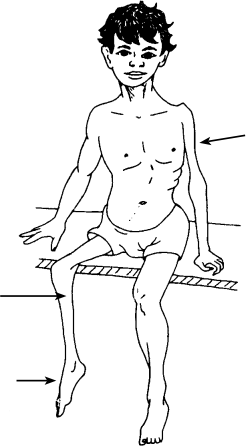Hesperian Health Guides
Chapter 7: Paralysis

Paralysis is muscle weakness that can affect any muscles of the body. This muscle weakness may prevent a person from moving those parts of their body. Paralysis may be caused by illness or injury, or by differences in how a baby develops during pregnancy. It may be caused by problems with parts of the nervous system (brain, spinal cord, nerves) or with the muscles themselves. Paralysis can begin suddenly or gradually. It may cause parts of a child’s body to become floppy and shrink, to become stiff and tight, or to feel numb or painful.
When paralysis affects a limb, the muscles of that limb may become smaller than those in the other limb. The bones may grow more slowly than in the other limb. Shortened muscles may cause contractures in joints to develop and joints may not be able to straighten all the way.
See the next page for information about some conditions that cause paralysis in children and how to identify them. We also discuss some of these conditions in more detail in several chapters:
- Cerebral Palsy
- Muscular Dystrophy
- Erb’s Palsy
- Tuberculosis of the Backbone
- Spina Bifida
- Spinal Cord Injury


